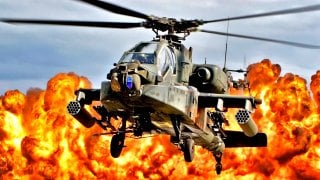AH-64 Apache Is America's Unstoppable Attack Helicopter
The AH-64 Apache is a pivotal asset in the U.S. Army's attack helicopter fleet, offering unmatched support to ground troops across various combat scenarios.
Summary: The AH-64 Apache is a pivotal asset in the U.S. Army's attack helicopter fleet, offering unmatched support to ground troops across various combat scenarios. Known for its heavy armament, including a 30mm M230 chain cannon, Hydra and CRV7 rockets, Hellfire missiles, and Stinger anti-aircraft munitions, the Apache excels in close air support, armed reconnaissance, and precision strikes.
-Celebrating four decades of service, with a production total nearing 1,300 units and over 5 million flight hours—1.3 million in combat—the Apache remains integral to U.S. military operations.
-Its capabilities were notably demonstrated during a 2007 mission in Afghanistan, highlighting its critical role in both attack and rescue missions. The Apache is expected to serve well into the 2060s, thanks to ongoing updates facilitated by its modular open system architecture.
AH-64 Apache: Four Decades of Dominance in U.S. Army Aviation
The AH-64 Apache attack helicopter is a grunt’s best friend. Ask any infantry troop, and he will tell you that few things make a soldier feel safer on the ground than knowing an AH-64 chopper is circling in the vicinity, monitoring the battlefield and ready to pounce.
The AH-64 Apache
The AH-64 Apache is an all-weather attack helicopter that specializes in deep precision strikes, close air support, and armed reconnaissance. It makes up the bulk of the U.S. Army’s attack rotary-wing capability.
Operated by a crew of two (pilot and co-pilot/gunner), the AH-64 Apache lives and dies by its weapons systems. The attack helicopter packs a heavy loadout, including a 30mm M230 chain cannon; Hydra 70mm AND CRV7 70mm air-to-ground rockets; AGM-114 Hellfire missiles; and AIM-92 Stinger anti-aircraft munitions.
What is great about the AH-64 Apache is its loiter time. The attack helicopter can stay above a target for long durations and provide critical close air support and Intelligence, Surveillance, and Reconnaissance capabilities to troops on the ground.
One outstanding feature of the AH-64 is the Integrated Helmet and Display Sighting System that allows pilots to move the 30mm M230 with their head and engage targets rapidly.
This year, the Apache closed four decades of operational flying. With the production line still open, the U.S. military expects to operate the attack helicopter well into the 2060s. Boeing has produced close to 1,300 aircraft that have accumulated an impressive 5 million flight hours, 1.3 million of which have taken place in combat.
The AH-64 Apache attack helicopter drew first blood during the invasion of Panama in 1989. Since then, it has seen action in countless conflicts, including Iraq, Bosnia, Kosovo, Afghanistan, and Syria. The attack chopper has also seen action with foreign operators, most notably with Israel.
The Army continues to invest in the attack helicopter. The AH-64’s modular open system architecture makes technology updates much easier to incorporate. Rather than designing a new version of the aircraft every time there is a major block of updates, Boeing and the Army can just update the existing version.
Aerial Cavalry
Perhaps one of the most striking events in the long history of the AH-64 took place in Afghanistan in 2007. A company of British Royal Marines commandos came under determined Taliban attack after a raid on a fortified position in Helmand Province.

The British commandos had to withdraw but left a wounded comrade behind in the confusion of the battle. Once they realized this, they sought to recover him. It was then that an AH-64 came to help. Four British marines jumped on the chopper, which is not meant to carry any troops, and stormed the compound.
Unfortunately, however, their comrade had perished before their daring rescue attempt.
About the Author
Stavros Atlamazoglou is a seasoned defense journalist specializing in special operations and a Hellenic Army veteran (national service with the 575th Marine Battalion and Army HQ). He holds a BA from the Johns Hopkins University and an MA from the Johns Hopkins’ School of Advanced International Studies (SAIS). His work has been featured in Business Insider, Sandboxx, and SOFREP.


